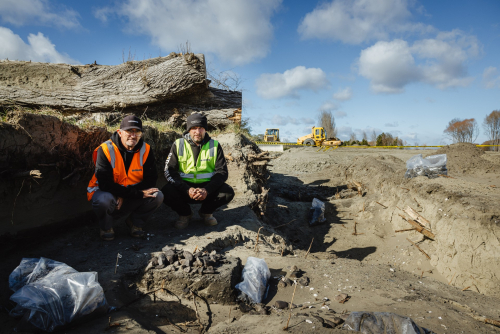
Current filter:

The discovery of a cluster of six midden pits west of Napier by a Hawke’s Bay Regional Council asset management team is the largest archaeologists have encountered in the region.
Middens were traditionally used by Māori for domestic waste, usually consisting of animal bones, shells, glass and ceramic artifacts, charcoal from fires, hangi stones and other traces from a settlement.
The middens were discovered along a 1km stretch of stopbank on Springfield Road during a repair and restoration project. Samples of the contents and soil have been taken for carbon dating, but estimates suggest they are from the mid-1800s.
Hawke’s Bay Regional Council Māori Partnerships’ Te Kaha Hawaikirangi says engaging mana whenua to work with archaeologists was instrumental in creating a new process for handling midden discoveries in the future.
“We worked with Heritage New Zealand who authorised the Regional Council to undertake works on the site. Throughout that authorisation process, we also engaged with mana whenua to provide a Cultural Values Report of the sites.
Everyone involved supported the urgency of completing the stopbank repairs and worked as quickly as possible. Kaitiaki/guardians worked alongside the archaeologist to identify, photograph and measure what was in the middens.
It is essential to have this cultural input from mana whenua, particularly for future discoveries because these middens are rich in history and give us an insight into how our ancestors lived here in Hawke’s Bay,” says Hawaikirangi.
While there weren’t any toki/adze found in the middens, there were a large number of shells and hangi stones, indicating food pits used by mana whenua from the area and/or groups transiting up and down the Tūtaekurī River.
The middens the repair team could excavate around and not disturb, were left in situ. Others were moved to a location nearby on the site, their contents buried and covered with geotextile fabric, a special woven and robust fabric that will protect the pits should any future excavation take place. The middens’ locations have also been mapped as significant archaeological sites.
“The Regional Council is committed to making connections with mana whenua and this project, where iwi monitors and kaitiaki worked alongside Heritage New Zealand archaeologists, is a proactive way we can do that. It has created a blueprint for the future,” says Hawaikirangi.
Contact Team Lead Communications Jenny Keown| Phone 027 202 4679
26 September 2023
Disclaimers and Copyright
While every endeavour has been taken by the Hawke's Bay Regional Council to ensure that the information on this website is
accurate and up to date, Hawke's Bay Regional Council shall not be liable for any loss suffered through the use, directly or indirectly, of information on this website. Information contained has been assembled in good faith.
Some of the information available in this site is from the New Zealand Public domain and supplied by relevant
government agencies. Hawke's Bay Regional Council cannot accept any liability for its accuracy or content.
Portions of the information and material on this site, including data, pages, documents, online
graphics and images are protected by copyright, unless specifically notified to the contrary. Externally sourced
information or material is copyright to the respective provider.
© Hawke's Bay Regional Council - www.hbrc.govt.nz / +64 6 835 9200 / info@hbrc.govt.nz